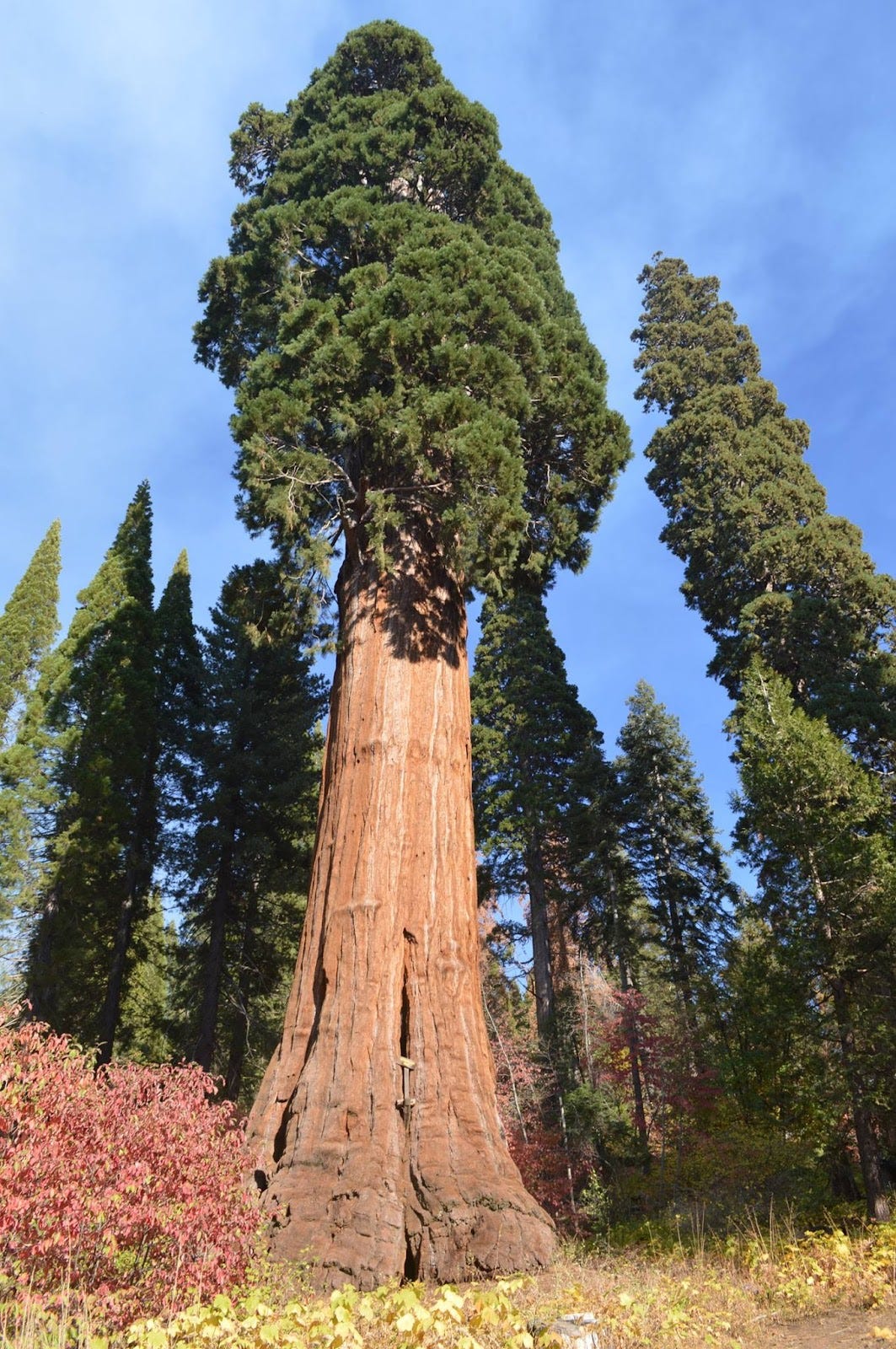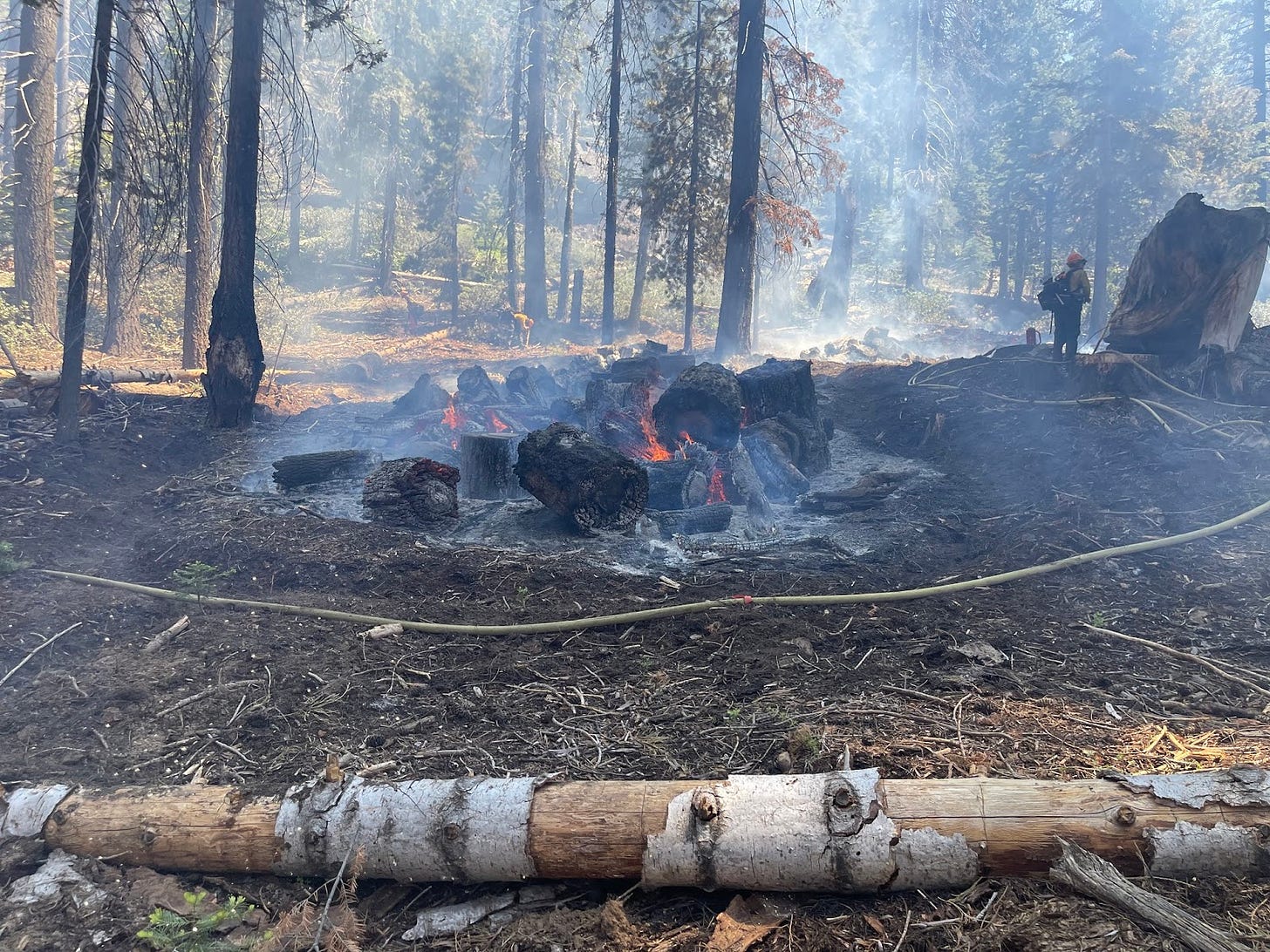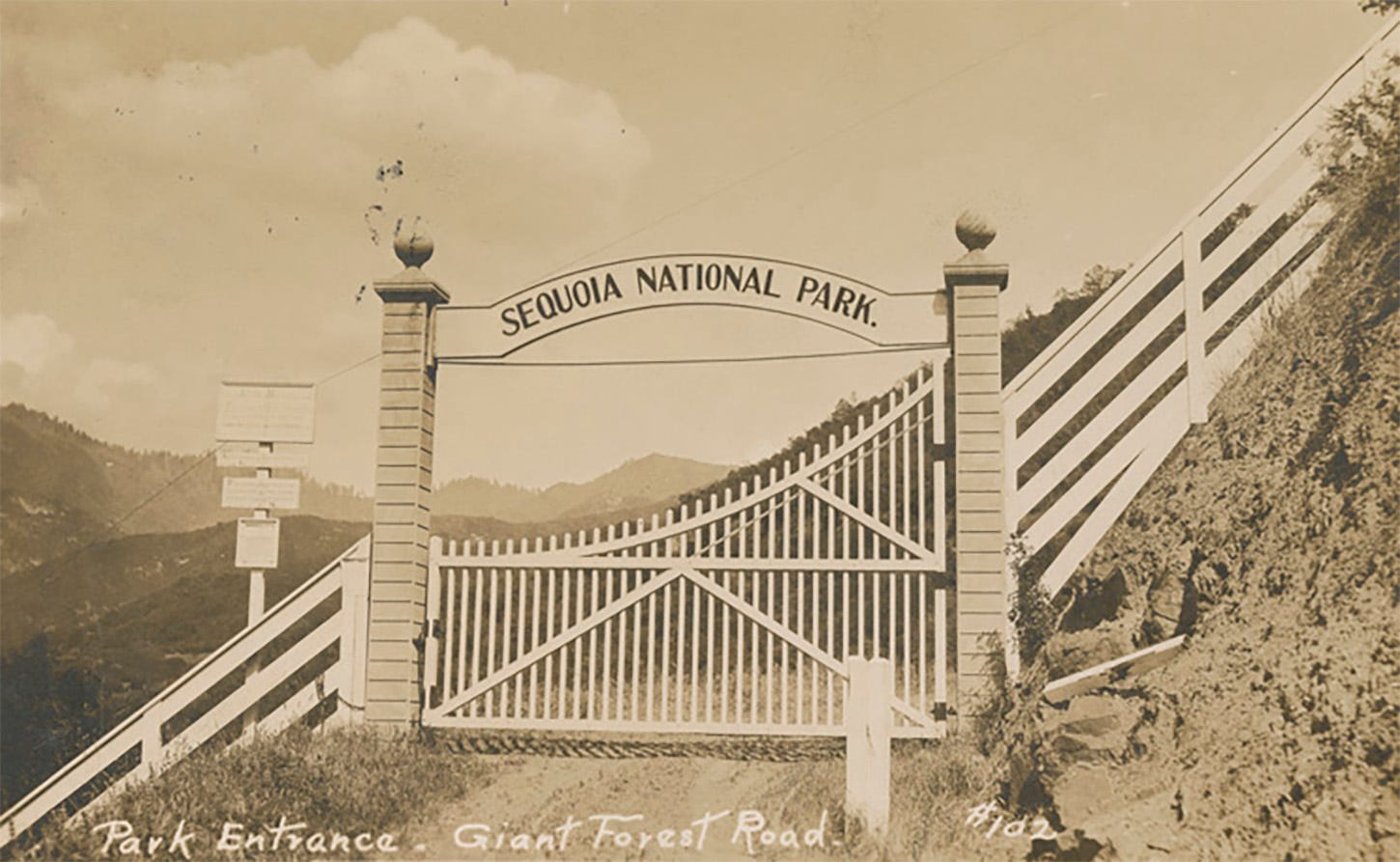Volume 1, Number 61 - Monday, June 26, 2023
Now twice a week — Monday and Thursday!

Perspective
THE MOUNTAIN HOME GROVE of giant sequoias has a special place in my heart.
Growing up, living in many places around California, I was used to spectacular natural places. But my father always told me that the most beautiful place in California was the giant sequoia groves in the mountains of Tulare County, where both he and my mother were born.
After I was grown, he was assigned to work as the Camp Commander at Mountain Home Conservation Camp in the mountains about 13 miles northeast of Springville. The camp first opened in 1947 under the direction of CalFire and the California Youth Authority. By the 1960s, the California Department of Corrections (now with the word “Rehabilitation” tacked on at the end) took over the manpower side of the operation. Prison inmates are supervised by CDCR staff and work under the direction of Cal Fire to respond to emergencies, such as wildfires and floods, and also cut fire breaks, maintain trails and do other work in the forest. (My father worked for corrections).
My parents lived nearby while my father was assigned to the camp, and I was able to visit many times and explore the surrounding area. I was heartbroken when the area was hit by the 2020 SQF/Castle Fire.
He was right about Tulare County’s giant sequoias and the Mountain Home Grove, known as the home of both the county’s Balch Park and Mountain Home Demonstration State Forest. And the area has a history as interesting as its Big Trees.
It was logged extensively in the late 1800s and early 1900s and then intermittently. In 1946, the state purchased the land and established California’s first state forest — the Mountain Home Demonstration State Forest. It was also the first demonstration forest — meant for scientific research and experimentation in sustainable forestry and the restoration of the local ecology.
Part of the research at Mountain Home included reconstruction of a 3,000-year fire history there, and in 1994 scientists at the University of Arizona’s Laboratory of Tree-Ring Research produced a report for Cal Fire (officially the California Department of Forestry and Fire Protection) that examined a fire of unusually high severity that occurred in the Mountain Home Grove in A.D. 1297.
In news reports following the 2020 Castle Fire, you may have read that “Prior to this year, the worst known fire season for sequoias was in 1297, the year in which William Wallace defeated the English at the Battle of Stirling Bridge, during the Medieval Warm Period.”
Yes, tree rings tell the story of that fire back in 1297, and it’s an interesting story. The full report by Anthony C. Caprio, Linda S. Mutch, Thomas W. Swetnam and Christopher H. Baisan is HERE. And here’s an excerpt:
“In the Mountain Home Grove of giant sequoias, we observed that a fire in A.D. 1297, recorded as scars on many trees, was followed by a growth release of unusually large magnitude and duration. The number of scarred trees and a growth release of this size suggested this fire event was of unusually high severity, not equaled over the last 2,000 years. We hypothesize that this event was associated with mortality of most non-sequoia tree species and a considerable number of giant sequoias.”
What’s a growth release? I didn’t know, so I looked it up and found that it's a ring-width increase. If I understand correctly, it indicates that the tree grew more that year, perhaps because of reduced competition from nearby trees that were damaged or killed. I found that information HERE.
And another excerpt:
“Using the magnitude of the growth release as a proxy of fire severity, we found that the spatial distribution of the 1297 fire impacts indicated the fire was most severe in the northern and central parts of the grove. Sequoia trees in peripheral areas had a smaller post-fire growth release. The post-fire growth release at Mountain Home was apparent for about 100 years… when pre-burn average growth was again equaled. The release was often preceded by a short period of suppressed growth in many trees, that we attributed to the severity of the burn.”
There was a time I would have referred to the Sierra Nevada wildfires of recent years as devastating. I’m trying to stay somewhere near the middle lane, and apparently, it’s better to call such fires “high severity.” Tree-ring scientists tell us the fire in the Mountain Home Grove in 1297 was high severity, and other scientists have told us that the recent fires that killed giant sequoia trees were high severity and also that the Big Trees are adapted to living with fire and, in fact, need it for regeneration.
But I’ve noticed opponents to the work in the groves being done by members of the Giant Sequoia Lands Coalition say that the trees can benefit from high severity wildfire also, and I suppose they may be referring to that fire back in 1297.
After reading the entire tree ring study report (you can read it HERE), I’ve concluded two things:
1.) I would need to know much more about climate history to really put this 1994 report in perspective, and;
2.) The fabulous forest I remember from my last visit to Balch Park and Mountain Home — before the Castle Fire — may have been due in part to that fire back in 1297.
I haven't been able to visit the area since the fire, and it’s still closed to the public because of winter storm damage. But Sue Cag, a naturalist and photographer who publishes the website ILoveTrees.net, has great information about the area before and after that fire. She posted THIS article on June 25, 2021 — in early summer, the year after the fire. Here’s a relevant excerpt:
“Because of its large size, Mountain Home may have lost more sequoias in number than any other grove. However, an incredible abundance of surviving green domes populate the center. It seems tricky to get an accurate understanding of the fire’s impact. Because the middle of the grove is so intact and beautiful, there’s a strange disconnect, as though the thousands of amazing sequoias that perished out of sight are no big deal.”
I wondered what story the tree rings of those “surviving green domes” might tell scientists someday. Will they show a “growth release” because their competitors turned to ash?
Cag also has a gallery of images from Mountain Home Grove after the fire HERE. And on the previously referenced page, she provided an update on some of the named giant sequoias at Mountain Home, including the “Methuselah Tree” pictured above. You can see more photos of Mountain Home Grove’s Methuselah HERE.
I wasn’t able to find information about the age of Methuselah (not to be confused with the Bristlecone Pine tree with the same name). But judging from its size, my guess is that it well exceeds 726 years and likely has seen many more centuries. This means that this tree survived the fire in 1297, and now its survived another high-intensity wildfire.
There is so much more to learn!

Wildfire, water & weather update
More whiplash weather in California. Apparently, we’re heading into triple digits in the San Joaquin Valley, which will mean higher temperatures in the nearby mountains — and may still have thunderstorms in the mountains to the north. The best Sierra Nevada weather forecasts can be found at NWS Hanford, HERE, and NWS Sacramento, HERE.
Wildfire update: Nothing new here. CalFire’s incident page reports it has responded to 1943 wildfires this season, with 6,709 acres burned. Yes, these are the same numbers I reported last Thursday, so I expect there may be an update later today. Fortunately, most wildfires so far have been contained with very little acreage and even the largest, the Geology fire on Joshua Tree National Monument, is now 100 percent contained. The federal InciWeb system shows more HERE, mostly shows prescribed burns and flood response.
Did you know you can comment here?
It’s easy to comment on items in this newsletter. Just scroll down, and you’ll find a comment box. You’re invited to join the conversation!
Giant sequoias in the news
• Reader Jim Hamerly’s giant sequoia grove on Palomar Mountain in San Diego County was featured in this NBC news report you can watch HERE.
• Here’s a PODCAST produced by the Forest Service about the reforestation of giant sequoias. And a TRANSCRIPT if you prefer to read. Here’s a short excerpt I found interesting:
“This expert who establishes and cares for forest trees shows us where a high-severity fire killed many trees, even fire-adapted, towering giant sequoias. This is a heavy loss. But as we learn about reforestation in post-fire landscapes, we also find a portrait of our recovery which invites us to hope for our own unhurried healing.”
• Folks in Michigan love their giant sequoias. Read an article about the 75th birthday of some beloved trees growing there HERE.
Historic photo of the week

Sometimes I get lost in research, and that was the case when I came upon this image from 1912. In addition to the Big Trees, there is so much fascinating history associated with the national parks — Sequoia, Kings Canyon and Yosemite. This brochure published by the NPS in 1923 — about halfway between the time the sign above was used and the more familiar Indian head sign carved from an ancient giant sequoia slab in the 1930s — was full of information and has great photos. And you can see another view of the entrance pictured above HERE.
Thanks for reading!




Great article providing some historical perspective. Today's fuel conditions, and probability of catastrophic fires are probably greater than in 1297.Though fire is natural, the accumulation of fuels during a period of drought/climate change, has created fire hazzards that are a real threat to existing Giant Sequoias over four feet dbh. There is no doubt that Giant Sequoias will regenerate. Consider this, If our goal is to do the best we can to preserve the giant monarchs that haven't been destroyed, we need forest management in the form of thinning white woods and using prescribed fire on a landscape wide basis.
Timber production is not the goal of Camp 70. Our goal is to preserve the giant trees that havent yet been destroyed. The big trees are dwindling and they must be protected. Whitewood removal and prescribed fire on a large scale will help us preserve the big trees. These management tools are just that--tools to help preserve the big trees. The larger vegetation must be removed following thinnings. Piling and burning of the thinned material has limited utility. Controlled fire alone can't be used on areas of heavy fuel without removals of the thinned/removed fuel. This includes snag removal of destroyed whitewoods and sequoias near the giant trees. There are alternatives to be explored. One size does not fit all areas.
We applaud the efforts of the Forest Service to attack the fuels issue. Unfortunately, the remedies are on a smaller scale that we would like to see. We also believe that the current staffing of the USFS in the Monument and on other national forests should be enhanced at a faster pace. Increased hiring has its own problems. Training new-hires could be problematic. There is an experienced gap that must be dealt with. Perhaps this is something you may wish to explore.
I will contact you regarding our visit to the south Sierra towards the end of July.
RonCerruti
Camp 70 Foresters
(925) 915-1669
Great reporting Claudia.